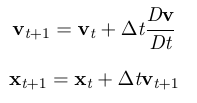
尝试写了一个简单基于weakly-compressible SPH 的流体求解器 ![]()
(taichi算起来真快啊
import numpy as np
import matplotlib.pyplot as plt
import time
from itertools import count
import taichi as ti
ti.init(arch=ti.cpu)
df_fac = 1.3
dx = 0.2
dh = dx * df_fac
###### Scene parameters ########
w = 20
h = 10
w_bound = 22
h_bound = 12
bottom_bound = 0.0
top_bound = 0.0
left_bound = 0.0
right_bound = 0.0
assert w_bound > w
assert h_bound > h
x_min = (w_bound - w) / 2.0
y_min = (h_bound - h) / 2.0
x_max = w_bound - (w_bound - w) / 2.0
y_max = h_bound - (h_bound - h) / 2.0
def computeGridIndex(x, y):
idx = np.floor(x / (2*dh)).astype(int)
idy = np.floor(y / (2*dh)).astype(int)
return idx, idy
def placeParticles(position_list, paticle_list, wall_mark, bound=0):
"""position_list: [start_x, start_y, end_x, end_y] """
start_x, start_y, end_x, end_y = position_list
vel_x, vel_y, p, rho = 0.0, 0.0, 0.0, 1000.0
for pos_x in np.arange(start_x, end_x, dx):
for pos_y in np.arange(start_y, end_y, dx):
paticle_list.append([pos_x, pos_y])
if bound:
wall_mark.append(0)
else:
wall_mark.append(1)
def setup():
particle_list = []
wall_mark = []
# Dam break
start_x = x_min + 0.5 * dx
start_y = y_min - 1.0 * dx
end_x = start_x + 0.5 * h
end_y = start_y + 0.5 * h
## Constrcut wall
# Bottom square
b_start_x = 0.0
b_start_y = 0.0
b_end_x = b_start_x + w
b_end_y = b_start_y + y_min - 2 * dx
bottom_bound = b_end_y
# Top square
t_start_x = 0.0
t_start_y = h - y_min + 2 * dx
t_end_x = t_start_x + w
t_end_y = h
top_bound = t_start_y
# left square
l_start_x = 0.0
l_start_y = y_min - 2 * dx
l_end_x = l_start_x + x_min - 2 * dx
l_end_y = l_start_y + h - 2 * y_min + 4 * dx
left_bound = l_end_x
# right square
r_start_x = w - x_min + 2 * dx
r_start_y = y_min - 2 * dx
r_end_x = w - dx
r_end_y = r_start_y + h - 2 * y_min + 4 * dx
right_bound = r_start_x
pos_list_fluid = [start_x, start_y, end_x, end_y]
placeParticles(pos_list_fluid, particle_list, wall_mark)
# These are boundaries
pos_list_bs = [b_start_x, b_start_y, b_end_x, b_end_y]
placeParticles(pos_list_bs, particle_list, wall_mark, bound=1)
pos_list_ts = [t_start_x, t_start_y, t_end_x, t_end_y]
placeParticles(pos_list_ts, particle_list, wall_mark, bound=1)
pos_list_ls = [l_start_x, l_start_y, l_end_x, l_end_y]
placeParticles(pos_list_ls, particle_list, wall_mark, bound=1)
pos_list_rs = [r_start_x, r_start_y, r_end_x, r_end_y]
placeParticles(pos_list_rs, particle_list, wall_mark, bound=1)
return particle_list,wall_mark, top_bound, bottom_bound, left_bound, right_bound
def makeGrid():
grid_size = 2*dh
num_x = np.ceil(w_bound / grid_size).astype(int)
num_y = np.ceil(h_bound / grid_size).astype(int)
grid_x = num_x
grid_y = num_y
return grid_x, grid_y
@ti.data_oriented
class sph_solver:
def __init__(self, particle_list,
wall_mark,
grid,
bound, dx=0.2, max_time=10000, max_steps=1000,gui=None):
######## Solver parameters ##########
self.max_time = max_time
self.max_steps = max_steps
self.gui = gui
# Gravity
self.g = -9.80
# viscosity
self.mu = 1e-3
# reference density
self.rho_0 = 1000.0
# CFL coefficient
self.CFL = 0.20
# Smooth kernel norm factor
self.kernel_norm = 1.0
# Pressure state function parameters
self.gamma = 7.0
self.c_0 = 20.0
###### Scene parameters ########
self.w = 20
self.h = 10
self.w_bound = 22
self.h_bound = 12
assert self.w_bound > self.w
assert self.h_bound > self.h
self.x_min = (self.w_bound - self.w) / 2.0
self.y_min = (self.h_bound - self.h) / 2.0
self.x_max = self.w_bound - (self.w_bound - self.w) / 2.0
self.y_max = self.h_bound - (self.h_bound - self.h) / 2.0
self.top_bound = bound[0] # top_bound
self.bottom_bound = bound[1] #bottom_bound
self.left_bound = bound[2] #left_bound
self.right_bound = bound[3] #right_bound
self.df_fac = 1.3
self.dx = 0.2
self.dh = self.dx * self.df_fac
self.kernel_norm = 10. / (7. * np.pi * self.dh ** 2)
###### Particles #######
self.dim = 2
self.particle_numbers = len(particle_list)
self.grid_x = grid[0]
self.grid_y = grid[1]
# Fluid particles
self.old_positions = ti.Vector(self.dim, dt=ti.f32)
self.particle_positions = ti.Vector(self.dim, dt=ti.f32)
self.particle_velocity = ti.Vector(self.dim, dt=ti.f32)
self.particle_pressure = ti.Vector(1, dt=ti.f32)
self.particle_density = ti.Vector(1, dt=ti.f32)
self.wall_mark_list = ti.Vector(1, dt=ti.f32)
self.d_velocity = ti.Vector(self.dim, dt=ti.f32)
self.d_density = ti.Vector(1, dt=ti.f32)
self.dx = dx
self.m = self.dx**2 * 1000
self.particle_list = np.array(particle_list)
self.wall_mark = np.array(wall_mark)
self.grid_num_particles = ti.var(ti.i32)
self.grid2particles = ti.var(ti.i32)
self.particle_num_neighbors = ti.var(ti.i32)
self.particle_neighbors = ti.var(ti.i32)
self.max_num_particles_per_cell = 100
self.max_num_neighbors = 100
ti.root.dense(ti.i, self.particle_numbers).place(self.old_positions, self.particle_positions,
self.particle_velocity, self.particle_pressure,
self.particle_density, self.d_velocity, self.d_density,
self.wall_mark_list)
grid_snode = ti.root.dense(ti.ij, (self.grid_x, self.grid_y))
grid_snode.place(self.grid_num_particles)
grid_snode.dense(ti.k, self.max_num_particles_per_cell).place(self.grid2particles)
nb_node = ti.root.dense(ti.i, self.particle_numbers)
nb_node.place(self.particle_num_neighbors)
nb_node.dense(ti.j, self.max_num_neighbors).place(self.particle_neighbors)
@ti.kernel
def init(self, p_list:ti.ext_arr(), w_list:ti.ext_arr()):
for i in range(self.particle_numbers):
for j in ti.static(range(self.dim)):
self.particle_positions[i][j] = p_list[i,j]
self.particle_velocity[i][j] = ti.cast(0.0, ti.f32)
self.d_velocity[i][0] = ti.cast(0.0, ti.f32)
self.d_velocity[i][1] = ti.cast(-9.8, ti.f32)
self.wall_mark_list[i][0] = w_list[i]
self.d_density[i][0] = ti.cast(0.0, ti.f32)
self.particle_pressure[i][0] = ti.cast(0.0, ti.f32)
self.particle_density[i][0] = ti.cast(1000.0, ti.f32)
@ti.func
def computeGridIndex(self, pos):
return (pos / (2 * dh)).cast(int)
@ti.kernel
def allocateParticles(self):
# allocate particles to grid
for p_i in self.particle_positions:
# Compute the grid index on the fly
cell = self.computeGridIndex(self.particle_positions[p_i])
# Use vector as index?
offs = self.grid_num_particles[cell].atomic_add(1)
self.grid2particles[cell, offs] = p_i
@ti.func
def is_in_grid(self, c):
return 0 <= c[0] and c[0] < self.grid_x and 0 <= c[1] and c[1] < self.grid_y
@ti.func
def isFluid(self, p):
return self.wall_mark_list[p][0]
@ti.kernel
def search_neighbors(self):
for p_i in self.particle_positions:
pos_i = self.particle_positions[p_i]
nb_i = 0
if self.isFluid(p_i) == 1:
# Compute the grid index on the fly
cell = self.computeGridIndex(self.particle_positions[p_i])
for offs in ti.static(ti.grouped(ti.ndrange((-1, 2), (-1, 2)))):
cell_to_check = cell + offs
if self.is_in_grid(cell_to_check):
for j in range(self.grid_num_particles[cell_to_check]):
p_j = self.grid2particles[cell_to_check, j]
if nb_i < self.max_num_neighbors and p_j != p_i and (
pos_i - self.particle_positions[p_j]).norm() < self.dh * 1.30:
self.particle_neighbors[p_i, nb_i] = p_j
nb_i += 1
self.particle_num_neighbors[p_i] = nb_i
@ti.func
def cubicKernel(self, r, h):
""" Return value of cubic spline smoothing kernel"""
k = 10. / (7. * np.pi * h ** 2)
q = r / h
assert q >= 0.0
res = ti.cast(0.0, ti.f32)
if q <= 1.0:
res = k * (1 - 1.5 * q ** 2 + 0.75 * q ** 3)
elif q < 2.0:
res = k * 0.25 * (2 - q) ** 3
return res
@ti.func
def cubicKernelDerivative(self, r, h):
""" Return derivative of cubcic spline smoothing kernel"""
k = 10. / (7. * np.pi * h ** 2)
q = r / h
assert q > 0.0
res = ti.cast(0.0, ti.f32)
if q < 1.0:
res = (k / h) * (-3 * q + 2.25 * q ** 2)
elif q < 2.0:
res = -0.75 * (k / h) * (2 - q) ** 2
return res
@ti.func
def rhoDerivative(self, ptc_i, ptc_j, r, r_mod, h):
"""Weakly compressible """
return self.m * self.cubicKernelDerivative(r_mod, h) \
* (self.particle_velocity[ptc_i]- self.particle_velocity[ptc_j]).dot(r / r_mod)
@ti.func
def pUpdate(self, rho, rho_0=1000, gamma=7.0, c_0=20.0):
"""Weakly compressible, tait function """
b = rho_0 * c_0 ** 2 / gamma
return b * ((rho / rho_0) ** gamma - 1.0)
@ti.func
def pressureForce(self, ptc_i, ptc_j, r, r_mod, h, mirror_pressure=0):
"""Compute the pressure force contribution, Symmetric Formula"""
res = ti.Vector([0.0, 0.0])
# Use pressure mirror method to handle boundary leak
if mirror_pressure == 1:
res = - self.m * (self.particle_pressure[ptc_i][0]/ self.particle_density[ptc_i][0] ** 2
+ self.particle_pressure[ptc_i][0]/self.rho_0**2)* self.cubicKernelDerivative(r_mod, h) * r / r_mod
else:
res = -self.m * (self.particle_pressure[ptc_i][0] / self.particle_density[ptc_i][0] ** 2
+ self.particle_pressure[ptc_j][0] / self.particle_density[ptc_j][0] ** 2) \
* self.cubicKernelDerivative(r_mod, h) * r / r_mod
return res
@ti.func
def viscosityForce(self, ptc_i, ptc_j, r, r_mod, h, mu=1e-3):
"""Compute the viscosity force contribution, Symmetric Formula"""
res = ti.Vector([0.0, 0.0])
res = mu * (1.0 / self.particle_density[ptc_i][0] ** 2 + 1.0 / self.particle_density[ptc_j][0] ** 2) \
* self.cubicKernelDerivative(r_mod, h) * (self.particle_velocity[ptc_i]- self.particle_velocity[ptc_j]) / r_mod
return res
@ti.kernel
def computeDeltas(self):
for p_i in self.particle_positions:
pos_i = self.particle_positions[p_i]
d_v = ti.Vector([0.0, 0.0])
d_rho = 0.0
if self.isFluid(p_i) == 1:
d_v = ti.Vector([0.0, -9.8])
for j in range(self.particle_num_neighbors[p_i]):
p_j = self.particle_neighbors[p_i, j]
pos_j = self.particle_positions[p_j]
mirror_pressure = 0
if self.isFluid(p_j) == 0:
mirror_pressure = 1
# Compute distance and its mod
r = pos_i - pos_j
r_mod = r.norm()
# Compute Density change
d_rho += self.rhoDerivative(p_i, p_j, r, r_mod, self.dh)
# Compute Viscosity force contribution
d_v += self.viscosityForce(p_i, p_j, r, r_mod, self.dh, self.mu)
# Compute Pressure force contribution
d_v += self.pressureForce(p_i, p_j, r, r_mod, self.dh, mirror_pressure)
self.d_velocity[p_i] = d_v
self.d_density[p_i][0] = d_rho
@ti.kernel
def updateTimeStep(self):
for p_i in self.particle_positions:
#pos_i = self.particle_positions[p_i]
if self.isFluid(p_i) == 1:
self.particle_positions[p_i] += self.dt * self.particle_velocity[p_i]
self.particle_velocity[p_i] += self.dt * self.d_velocity[p_i]
self.particle_density[p_i][0] += self.dt * self.d_density[p_i][0]
self.particle_pressure[p_i][0] = self.pUpdate(self.particle_density[p_i][0], self.rho_0, self.gamma, self.c_0)
def solve(self):
# Compute dt, a naive initial test value
self.dt = 0.1 * self.dh / self.c_0
print("Time step: ", self.dt)
print("Domain: (%s, %s, %s, %s)" % (self.x_min, self.x_max, self.y_min, self.y_max), )
print("Fluid area: (%s, %s, %s, %s)"%(self.left_bound, self.right_bound, self.bottom_bound, self.top_bound))
print("Grid: (%d, %d)"%(self.grid_x, self.grid_y))
step = 1
t = 0.0
total_start = time.process_time()
while t < self.max_time and step < self.max_steps:
curr_start = time.process_time()
self.solveUpdate()
max_v = np.max(np.linalg.norm(self.particle_velocity.to_numpy(),2, axis=1))
max_a = np.max(np.linalg.norm(self.d_velocity.to_numpy(),2, axis=1))
max_rho = np.max(self.particle_density.to_numpy())
max_pressure = np.max(self.particle_pressure.to_numpy())
curr_end = time.process_time()
t += self.dt
step += 1
# CFL analysis
dt_cfl = self.dh / max_v
dt_f = np.sqrt(self.dh / max_a)
dt_a = self.dh / (self.c_0 * np.sqrt((max_rho / self.rho_0)**self.gamma))
self.dt = self.CFL * np.min([dt_cfl, dt_f, dt_a])
if step % 10 == 0:
print("Step: %d, physics time: %s, progress: %s %%, time used: %s, total time used: %s"
% (step, t, 100*np.max([t / self.max_time, step / self.max_steps]), curr_end-curr_start, curr_end-total_start))
print("Max velocity: %s, Max acceleration: %s, Max density: %s, Max pressure: %s" % (max_v, max_a, max_rho, max_pressure))
print("Adaptive time step: ", self.dt)
self.render(step, self.gui)
total_end = time.process_time()
print("Total time used: %s " % (total_end - total_start))
def solveUpdate(self):
self.grid_num_particles.fill(0)
self.particle_neighbors.fill(-1)
self.allocateParticles()
self.search_neighbors()
# Compute delta
self.computeDeltas()
# Update
self.updateTimeStep()
def isFluidNP(self, p):
return self.wall_mark[p]
def render(self, step, gui):
canvas = gui.canvas
canvas.clear(bg_color)
pos_np = self.particle_positions.to_numpy()
fluid_p = []
wall_p = []
for i, pos in enumerate(pos_np):
if self.isFluidNP(i) == 1:
fluid_p.append(pos)
else:
wall_p.append(pos)
fluid_p = np.array(fluid_p)
wall_p = np.array(wall_p)
for pos in fluid_p:
for j in range(self.dim):
pos[j] *= screen_to_world_ratio / screen_res[j]
for pos in wall_p:
for j in range(self.dim):
pos[j] *= screen_to_world_ratio / screen_res[j]
gui.circles(fluid_p, radius=particle_radius, color=particle_color)
gui.circles(wall_p, radius=particle_radius, color=boundary_color)
gui.show()
def main():
gui = ti.GUI('SPH2D', screen_res)
grid_shape = makeGrid()
particle_list,wall_mark, u, b, l, r = setup()
sph = sph_solver(particle_list, wall_mark, grid_shape, [u,b,l,r], dx = dx, gui=gui, max_steps=10000)
sph.init(sph.particle_list, sph.wall_mark)
sph.solve()
print('done')
screen_res = (800, 400)
screen_to_world_ratio = 35.0
bg_color = 0x112f41
particle_color = 0x068587
boundary_color = 0xebaca2
particle_radius = 3.0
particle_radius_in_world = particle_radius / screen_to_world_ratio
main()


 )。而是先计算d_rho,
)。而是先计算d_rho,



